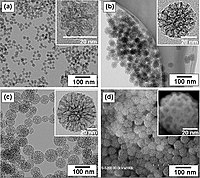
Photo from wikipedia
Abstract Fluorescent water-dispersible conjugated polymeric nanoparticles (WDCPNs) were synthesized for cellular imaging. Sonogashira polycondensations of various combinations of symmetric monomers (Ax + By, x > 2, y ≥ 2) were firstly conducted in confined nanoreactors to… Click to show full abstract
Abstract Fluorescent water-dispersible conjugated polymeric nanoparticles (WDCPNs) were synthesized for cellular imaging. Sonogashira polycondensations of various combinations of symmetric monomers (Ax + By, x > 2, y ≥ 2) were firstly conducted in confined nanoreactors to produce soluble conjugated polymeric nanoparticles (SCPNs) with narrow size distribution and tunable fluorescences emission. The subsequent click reaction between the terminal alkyne groups in the SCPNs and azide terminated PEG1000 endowing good dispersity of the WDCPNs in aqueous solutions and stable fluorescence emission. The WDCPNs exhibited bright fluorescence in cellular imaging and showed good biocompatibility as revealed by cell variability assay, demonstrating them as ideal fluorescent probes for biological imaging and detection.
Journal Title: European Polymer Journal
Year Published: 2018
Link to full text (if available)
Share on Social Media: Sign Up to like & get
recommendations!